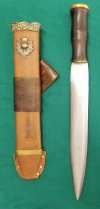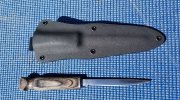I've got sort of that same thing but I ground the nose straight so I had two edges for scraping. Makes a fantastic glue scraper. I may have to try the 45º bevel on another file.Many years ago when I worked as an auto mechanic, I made a gasket scraper from an old file...I clamped it in a vise and broke it at about 6" long, ground the end straight then beveled it to 45 deg, then used the side of the grinder to grind the "teeth" about 2" back on the bottom side...it was/still is the best, easiest to use gasket scraper I've ever used.
Grinding hardened steel isn't difficult but it is slow. An angle grinder and wet rag helps if one gets too aggressive. The angle grinder gets the rough shape but precise, it isn't.


